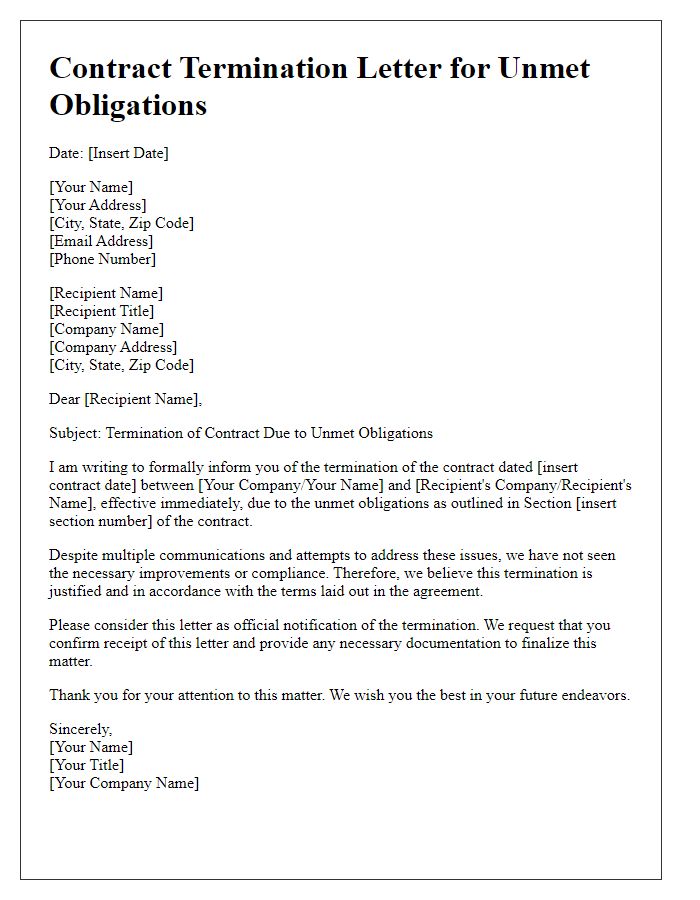Are you navigating the tricky waters of a non-compliance contract termination? It can feel overwhelming, but knowing the right steps is crucial to protect your interests. In this article, we'll break down how to draft a clear and effective letter template that conveys your position while retaining professionalism. So, if you're ready to learn more about ensuring a smooth termination process, let's dive in!

Clear Identification of Parties
In a non-compliance contract termination scenario, clear identification of parties is crucial for legal clarity. The contracting parties, often referred to as "Party A" and "Party B," must be distinctly named, along with their respective addresses, business registration numbers, and contact details. For instance, in a service agreement, "Party A" may be identified as "XYZ Corporation, a Delaware corporation located at 123 Business Rd, Wilmington, DE 19801," while "Party B" could be detailed as "ABC LLC, a Florida limited liability company with principal office at 456 Client St, Miami, FL 33101." This precise identification mitigates ambiguity, ensuring that any referenced actions, obligations, or rights are clearly attributed to the respective parties in the context of the termination due to non-compliance. Inclusion of role descriptions, such as "Supplier" or "Customer," enhances understanding of each party's position in the contract.
Specific Non-Compliance Terms
Non-compliance with contractual obligations can lead to termination under specific terms outlined in the legal agreement. For instance, failure to meet delivery deadlines (such as a stipulated 30-day period) or quality standards defined in Section 4 (e.g., product defects exceeding 2% of total units) can trigger termination. Notices are often required, detailing the nature of non-compliance and providing a 14-day period for remedy. Contracts typically specify eligible termination grounds, which may include persistent failure to address issues within defined timelines. Compliance monitoring procedures and corrective action plans are essential components to avoid further escalation and potential legal ramifications.
Reference to Contract Clauses
Contractual non-compliance can lead to termination, as outlined in specific contract clauses. Non-compliance refers to the failure to adhere to agreed terms, impacting project timelines and deliverables. The contract's termination clause, often found in Sections 12 and 14, details processes and implications associated with terminating the agreement. Additionally, the breach of contract clause identifies the responsibilities of both parties upon non-compliance, such as penalties or potential litigation. Essential dates, such as the initial signing date (January 15, 2023) and compliance review dates (March 1, 2023), highlight critical moments that can affect contractual obligations. Specific performance metrics or milestones set forth in Annex B provide measurable criteria for assessing compliance. Ignoring these stipulations may lead to significant financial repercussions or an adverse legal outcome.
Termination Date
Non-compliance in contractual obligations can lead to termination events, often specified in business agreements. For instance, a termination date may be outlined in a service contract between a corporation and a vendor, permitting an official end to the agreement due to failure to meet delivery schedules or quality standards. The notice period typically spans 30 days from the notification date, providing time for remediation or responses to the non-compliance issue. Legal repercussions may arise, requiring a review by attorneys specializing in contract law. Following a termination event, relationships may shift, impacting future collaborations and vendor evaluations in industries such as technology, manufacturing, or service sectors.
Contact Information for Queries
Non-compliance with contract terms can lead to termination, particularly in agreements such as service contracts or commercial leases. Relevant details include the specific clause indicating the grounds for termination, the date of notification (typically 30 days from the notice), and the requirements for remedying the non-compliance, often defined in Sections 4 and 7 of the contract. In many cases, the affected party may be required to submit queries to a designated compliance officer or legal representative whose contact information should be clearly stated in the correspondence, including phone numbers (e.g., +1 555-123-4567) and email addresses (such as compliance@company.com). The importance of prompt communication ensures adherence to contractual obligations and minimizes potential legal disputes.
Letter Template For Non-Compliance Contract Termination Samples
Letter template of Notification of Contract Cancellation for Non-Compliance

Letter template of Final Notice for Contract Non-Compliance and Termination












Comments